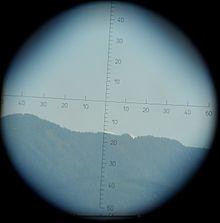Thread net
The term “ thread net” or reticle of a measuring or other telescope is understood to mean the glass plate with fine lines attached to the inner side of the eyepiece .

They are used to estimate or measure small angles and are either delicately engraved or photographically exposed on the glass .
The simplest case of a reticle is the crosshair . The micrometer , a particularly close-meshed graticule, enables precise angle or distance measurement and is mainly used in astrometry and microscopy. For astronomical instruments there were simple versions as early as 1700, for microscopes in the 19th century.
If you place the crosshairs of a theodolite on an object, its horizontal and elevation angles can be measured simultaneously. The separate setting is somewhat more precise ( approx. 1 " at 30x magnification ).
Reticle
The reticle is located in the inner (object-side) focal point of the eyepiece and therefore appears sharp to the normal eye . For farsightedness or nearsightedness, there is a diopter compensation .
In focusing the telescope to infinity (de facto from several kilometers), the glass plate in the focus of is objective . If the viewed object is closer, the telescope is extended by an extendable tube or an inner focusing lens is moved.
The reticle can consist of a few lines or a whole thread network. The latter is common in astronomy and astrometry in order to achieve greater accuracy in position or time measurement .
Theodolite
As a rule, simpler thread networks are used in geodesy ; usually the more important vertical thread is half double and one half. The double thread is about 20 "apart and is suitable for measuring many targets:
- Range pole (escape pole) from a distance of 10–200 meters
- Bar from distances of about 20 to 500 meters
- Church tower or chimney from a few kilometers.
Military telescopes
The so-called reticles often have lines or a network of threads in line division (~ 6283 ≙ 2π * 1000 lines are 360 °). The distance is calculated as follows:
Distance = 1000 × size of the object / number of lines that the object fills in the binoculars.
Example: a car (length approx. 6 meters) covers 12 lines.
1000 × 6 m / 12 = 500 m (distance observer - car).
This memorable phrase is often taught to prospective soldiers:
"A thousand times the target width - divided by a line - gives the width"
Marine glasses
As a reticle, these often have a vertical and a horizontal reticle, these are used to determine the distance, vertical line graduation results in: Distance = (object size / number of lines) × 100.
Special feature of the horizontal lines: These show half a step size, as the object is taken in the middle and the line size is read on one side. The division of lines is divided into degrees, so that the distance = (object size / number of lines) × (360 / 2π) = (object size / number of lines) × 57.32 is calculated using the radian measure.
A compass is displayed in many glasses.
See also
- Reticle (“crosshair”) for marking in the weapon telescope image
- Crosshair eyepiece
- Eyepiece micrometer
- Object micrometers in microscopy
- Circular micrometers in astronomy
- Line cross parallax

